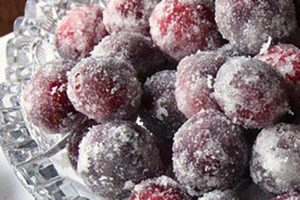
Baking sugars by India Tree add more to desserts than just calories. By virtue of their processing, they add a depth of flavor that mass-produced commercial sugars cannot deliver.
 By Nancy Pollard
By Nancy Pollard
A MAGICAL yet subtle transformation occurs in your chocolate dessert when you substitute Light or Dark Muscovado sugar for at least half of the white sugar in your recipe. The dish has more depth, with a caramel flavor that enhances the bitterness of the chocolate. And I do mean Muscovado sugar, not the pallid substitute packaged by Domino and its competitors. In reality, that’s nothing more than processed white sugar with a surface “paint” of molasses, as nicely pointed out by baking guru Rose Levy Beranbaum:
“When it comes to light brown and dark brown sugar, however, refining results in flavor differences that are even more significant. Because partially refined brown sugar still contains some of its natural molasses, it has bright, clear color and rich taste with delicious underlying flavor components. Refined brown sugar, such as beet sugar, which must have its molasses removed as it is not deemed fit for human consumption, however, has had all the molasses removed and then other molasses added back, at the expense of considerable depth of flavor. This is partially because an inferior grade of industrial molasses is often used and the molasses merely coats the outside of the sugar crystal and is no longer part of the crystal itself. In some cases food color, which is flavorless, is used instead of molasses to re-create the original brown appearance. This process is known as painting. A simple test to determine if the molasses has been removed and then added back is to add a spoonful of sugar to a glass of water. After just a few minutes, the water in the ‘painted’ sugar will turn a pale brown and the sugar crystals will be clear. With partially refined sugar that still contains its natural molasses, the water will remain clear and the sugar crystals brown.”
How Mauritius Makes Sugar Cane Sensible
This brings us to a remarkable supplier of sugar, which we featured at La Cuisine for over 15 years. India Tree is a quality-driven company that is virtually the largest buyer of first-rate Muscovado sugar from Mauritius, and they have spent a lot of time working with the modern sugar mills, family plantations, and farms there. Sugar from Mauritius is certified as Fair Trade. And here is something interesting to note: Most of the mills operate as co-generation plants, meaning that all the energy needed to process the sugar is generated by the process itself, with the excess sold to the national grid—and that accounts for 46% of the nation’s power supply.
And Wait, There’s More That Cane Is Used For
 The entire sugar industry is overseen and regulated by the government and the Mauritius Sugar Syndicate. All mills have their own laboratories, and quality controls are strictly enforced. In fact, at the university level, agricultural research departments continue to search for improved strains of sugar cane that are naturally disease- and pest-resistant. NO PESTICIDES ARE USED. Herbicides, yes. But they are applied to the cane before planting. Irrigation systems have been devised to conserve water. Most plantations make sure that every part of the cane plant is put to good use, so really nothing is wasted. The leaves become thatching for roofs, or field covering after harvesting to conserve moisture. Good to note that sub-tropical countries are hit by weather extremes far more than we are in the US. The scum that arises from purifying is then returned to the plantations and farms for fertilizer. “Bagasse” (from the spent canes) is burned for fuel or sold to reprocessors. Vapor from the evaporation process generates energy for the manufacturer and is also for sale to the national grid. Even ethanol is a by-product, used to generate energy (and also a rum particular to Mauritius!). Since this island is a part of a chain of ancient volcanic eruptions, the lava rocks that are an irritation in the fields are used to make walls or crushed to make cement. All incredibly efficient.
The entire sugar industry is overseen and regulated by the government and the Mauritius Sugar Syndicate. All mills have their own laboratories, and quality controls are strictly enforced. In fact, at the university level, agricultural research departments continue to search for improved strains of sugar cane that are naturally disease- and pest-resistant. NO PESTICIDES ARE USED. Herbicides, yes. But they are applied to the cane before planting. Irrigation systems have been devised to conserve water. Most plantations make sure that every part of the cane plant is put to good use, so really nothing is wasted. The leaves become thatching for roofs, or field covering after harvesting to conserve moisture. Good to note that sub-tropical countries are hit by weather extremes far more than we are in the US. The scum that arises from purifying is then returned to the plantations and farms for fertilizer. “Bagasse” (from the spent canes) is burned for fuel or sold to reprocessors. Vapor from the evaporation process generates energy for the manufacturer and is also for sale to the national grid. Even ethanol is a by-product, used to generate energy (and also a rum particular to Mauritius!). Since this island is a part of a chain of ancient volcanic eruptions, the lava rocks that are an irritation in the fields are used to make walls or crushed to make cement. All incredibly efficient.
But Back to the Sugars You Should Use
 The first sugar to be created from this farm-to-mill process is Demerara. The liquid cane juice is “seeded” to form large, crunchy crystals of free-flowing sugar. Demerara is a favorite for use in coffee or to top baked goods and espresso drinks. It is great on yogurt and hot cereal or as a topping for cookies, such as Stephanie’s divine Pumpkin Cookies. You can make a lovely syrup to be used in drinks or fruit compotes. It is the best sugar to use in crème brulée. At La Cuisine, the Cuisinettes tried all sorts of sugars, from processed white to some of the more exotic ones, and Demerara walked away as the burnt hero.
The first sugar to be created from this farm-to-mill process is Demerara. The liquid cane juice is “seeded” to form large, crunchy crystals of free-flowing sugar. Demerara is a favorite for use in coffee or to top baked goods and espresso drinks. It is great on yogurt and hot cereal or as a topping for cookies, such as Stephanie’s divine Pumpkin Cookies. You can make a lovely syrup to be used in drinks or fruit compotes. It is the best sugar to use in crème brulée. At La Cuisine, the Cuisinettes tried all sorts of sugars, from processed white to some of the more exotic ones, and Demerara walked away as the burnt hero.
Light Muscovado sugar is the second to emerge from the evaporating process. It is heavier in molasses than the Demerara, but lighter in flavor than the Dark Muscovado. It improves all recipes calling for light brown sugar. It can also be used as a substitute in most recipes calling for white granulated sugar. When used in this way, it will add a distinctly richer flavor. Favorite uses for Light Muscovado Sugar include: baked beans, chocolate chip cookies, gingerbread, coffee cake, cereals, pralines, and pecan pie. Personally, this is my go-to sugar for baking. I may mix it with India Tree’s Caster sugar in a blender to create what you can get in Europe as a fine golden sugar for baking.
Dark Muscovado sugar is last to be created during the evaporation process. It is moist, and has a strong molasses flavor with chocolate and tropical fruit overtones. It goes well with whole grains, vanilla, chocolate, butterscotch, cinnamon, and ginger. It is great in coffee, on hot cereals, and over French toast. It has been used to flavor ice cream, hot chocolate, gingerbread, butterscotch pots de crème, granola bars, and cinnamon rolls. It also adds depth to rib rubs, barbecue sauces, and hot chili.
The 411 on India Tree’s White Sugar

Caster sugar is finer than superfine sugar and works well dusted on seasonal fruit. / Photo by Nancy Pollard.
Caster sugar is something of a mystery to American bakers. It is a white milled sugar that is more refined than grocery-store superfine. Caster sugar is always cane sugar, whereas superfine is usually made from beet sugar. Use it in cakes, cookies, meringues, custards, and mousses. Because it dissolves quickly, India Tree Caster Sugar is perfect for sweetening iced tea and cold drinks. It is the best sugar for sorbets, or sprinkled over seasonal fresh fruits. It is a domestic product and is formulated for the baking trade, which has higher standards than we lowly consumers have. While it is not certified organic, is is a non-GMO cane sugar and is Crc Kosher.

The essential difference in India Tree sugar, used in or on sweets, is evident in depth of flavor. / Photo by Nancy Pollard.
India Tree’s Icing or Fondant Sugar is a superior form of the confectioner’s sugar you see in the grocery store. The finest commercially available, and specifically formulated for the baking trade, this particular icing sugar is micro-pulverized to twice the fineness of ordinary powdered sugar.
Preferred by industry professionals for its ease of application and ultra smooth texture, it is the ideal choice for achieving exceptionally silky fondants and high-gloss icings and glazes. It contains 3% cornstarch to prevent caking and is Crc Kosher but is not certified organic or non-GMO.
Check out our Easy Peasy Video on using India Tree Caster sugar to make a silky zabaglione, a recipe you can keep in your head for all dinner-guest emergencies. In the meantime, India Tree also makes a whole line of sugar products, including decorating sugars (such as the chocolate sprinkles shown on the front and at the top of the page), plus spice mixes and dried mushrooms and such. There is a store locator on their website or you can purchase all of the products on Amazon.com.
After owning one of the best cooking stores in the US for 47 years—La Cuisine in Alexandria, Virginia—Nancy Pollard writes Kitchen Detail, a blog about food in all its aspects—recipes, film, books, travel, superior sources, and food-related issues.



OK. Thank you, little birds. Very nice to know. Essential actually. Really, really could have used this info one month ago!!!!